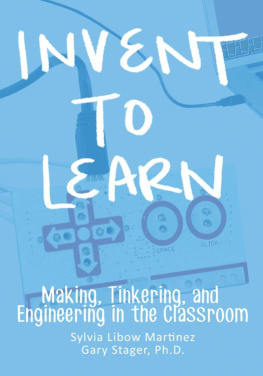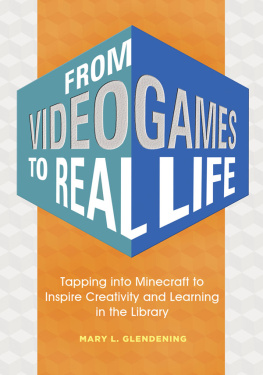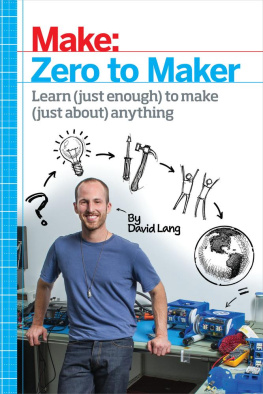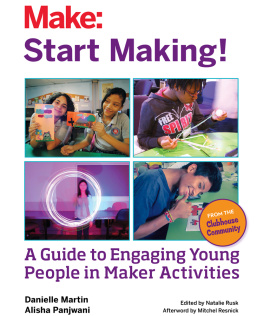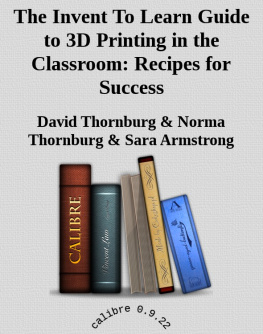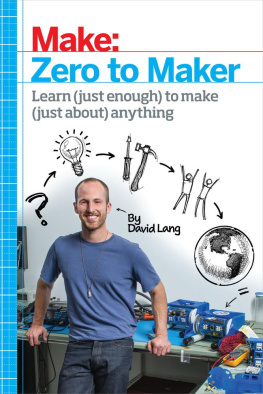Sylvia Libow Martinez - Invent To Learn: Making, Tinkering, and Engineering in the Classroom
Here you can read online Sylvia Libow Martinez - Invent To Learn: Making, Tinkering, and Engineering in the Classroom full text of the book (entire story) in english for free. Download pdf and epub, get meaning, cover and reviews about this ebook. year: 2013, publisher: Constructing Modern Knowledge Press, genre: Romance novel. Description of the work, (preface) as well as reviews are available. Best literature library LitArk.com created for fans of good reading and offers a wide selection of genres:
Romance novel
Science fiction
Adventure
Detective
Science
History
Home and family
Prose
Art
Politics
Computer
Non-fiction
Religion
Business
Children
Humor
Choose a favorite category and find really read worthwhile books. Enjoy immersion in the world of imagination, feel the emotions of the characters or learn something new for yourself, make an fascinating discovery.
- Book:Invent To Learn: Making, Tinkering, and Engineering in the Classroom
- Author:
- Publisher:Constructing Modern Knowledge Press
- Genre:
- Year:2013
- Rating:3 / 5
- Favourites:Add to favourites
- Your mark:
Invent To Learn: Making, Tinkering, and Engineering in the Classroom: summary, description and annotation
We offer to read an annotation, description, summary or preface (depends on what the author of the book "Invent To Learn: Making, Tinkering, and Engineering in the Classroom" wrote himself). If you haven't found the necessary information about the book — write in the comments, we will try to find it.
Theres a technological and creative revolution underway. Amazing new tools, materials and skills turn us all into makers. Using technology to make, repair or customize the things we need brings engineering, design and computer science to the masses. Fortunately for educators, this maker movement overlaps with the natural inclinations of children and the power of learning by doing. The active learner is at the center of the learning process, amplifying the best traditions of progressive education. This book helps educators bring the exciting opportunities of the maker movement to every classroom.
Children are natural tinkerers
Their seminal learning experiences come through direct experience with materials. Digital fabrication, such as 3D printing and physical computing, including Arduino, MaKey MaKey and Raspberry Pi, expands a childs toy and toolboxes with new ways to make things and new things to make. For the first time ever, childhood inventions may be printed, programmed or imbued with interactivity. Recycled materials can be brought back to life.
While school traditionally separates art and science, theory and practice, such divisions are artificial. The real world just doesnt work that way! Architects are artists. Craftsmen deal in aesthetics, tradition and mathematical precision. Video game developers rely on computer science. Engineering and industrial design are inseparable. The finest scientists are often accomplished musicians. The maker community brings children, hobbyists and professionals together in a glorious celebration of personal expression with a modern flare.
When 3-D printing, precision cutting, microcomputer control, robotics and computer programming become integral to the art studio, auto shop or physics lab, every student needs access to tools, knowledge and problem solving skills. The maker movement not only blurs the artificial boundaries between subject areas, it erases distinctions between art and science while most importantly obliterating the crippling practice of tracking students in academic pursuits or vocational training. There are now multiple pathways to learning what we have always taught and things to do that were unimaginable just a few years ago.
Making for every classroom budget
Even if you dont have access to expensive (but increasingly affordable) hardware, every classroom can become a makerspace where kids and teachers learn together through direct experience with an assortment of high and low-tech materials. The potential range, breadth, power, complexity and beauty of projects has never been greater thanks to the amazing new tools, materials, ingenuity and playfulness you will encounter in this book.
In this practical guide, Sylvia Martinez and Gary Stager provide K-12 educators with the how, why, and cool stuff that supports classroom making.
Sylvia Libow Martinez: author's other books
Who wrote Invent To Learn: Making, Tinkering, and Engineering in the Classroom? Find out the surname, the name of the author of the book and a list of all author's works by series.

